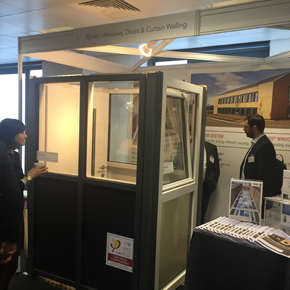
Lots of questions at the Passivhaus conference
Malcolm Taylor, Product Manager at REHAU answers questions posed at last weeks Passivhaus conference at the Business Design centre in Islington.
 Last week, REHAU exhibited at the Passivhaus conference at the Business Design Centre in Islington and once again it was very encouraging to see such a good turnout.
Last week, REHAU exhibited at the Passivhaus conference at the Business Design Centre in Islington and once again it was very encouraging to see such a good turnout.
I would estimate that close to 350 architects and specifiers were at the event and certainly the Masterclass event I attended on the day before the main conference, on the new Passivhaus Plus and Passivhaus Premium classifications, was sold out well in advance.
What this revealed was that the traditional Passivhaus as most of us understand it is now to be classified as Passivhaus Classic.
Added to this are Passivhaus Plus in which the building generates as much energy as residents consume (for example via photovoltaics) and Passivhaus Premium which generates additional energy which can either be stored for future use or sold back to the grid.
There’s lots of work still to be done on refining the requirements for these classifications and I’ll be covering this in a future post.
From our point of view, there were lots of visitors coming to our stand at the conference to look at the windows, doors and curtain walling sections we were showing.
Interestingly, there were some general questions from visitors which came up time and again, so I thought this might be a good place to answer them.
In terms of windows, architects wanted to know why the choice is generally restricted to tilt and turn options.
This is largely just because these window systems come from Germany, where Passivhaus was born and where tilt and turn is the equivalent of our casement.
Fundamentally though, they have become popular in the UK and proved a better solution for Passivhaus installations because they incorporate locking points all the way round the frame, which means it is possible to get a better and more reliable airtight seal than would be possible with a casement window where the locking points are just on the sash.
Another common question was ‘why do the PVC-U windows have bigger sightlines than timber?’ and the answer to that one is that in Passivhaus technologies, they generally don’t.
There are now Passivhaus approved aluminium clad PVC-U composite windows available with sightlines which are even slimmer than aluminium clad timber.
The market has moved on and recognised that aesthetics are almost as important as performance – that’s also the reason of course why manufacturers now offer such a wide range of colours and finishes in PVC-U and composite materials.
The days of the white PVC-U window have long gone.
Contact:
REHAU
Hill Court,
Walford,
Ross on Wye,
Herefordshire,
HR9 5QN
Email address: [email protected]
Tel: 01989 72600
Visit Supplier's page
Latest news

18th April 2024
Abloy UK showcases new digital portfolio at The Security Event 2024
Abloy UK is set to unveil its latest line-up of access control systems at The Security Event 2024, welcoming guests to explore its cutting-edge electromechanical and digital solutions on stand 5/F50.
Posted in Access Control & Door Entry Systems, Architectural Ironmongery, Articles, Building Industry Events, Building Industry News, Building Products & Structures, Building Services, Doors, Exhibitions and Conferences, Facility Management & Building Services, Health & Safety, Information Technology, Retrofit & Renovation, Security and Fire Protection
18th April 2024
Strand is a Failsafe Choice for Emergency Exit and Panic Hardware
In times of emergency, you’re in safe hands with Strand Hardware. Although there are many considerations for building specification, few decisions can be as critical as selecting the right emergency exit/panic hardware.
Posted in Access Control & Door Entry Systems, Architectural Ironmongery, Articles, Building Industry News, Building Products & Structures, Building Services, Doors, Facility Management & Building Services, Health & Safety, Restoration & Refurbishment, Retrofit & Renovation, Security and Fire Protection
18th April 2024
MRA appoints Callum Budd as Research Projects Director
MRA Research, the research agency focused solely on the construction sector, welcomes Callum Budd as its new Research Projects Director.
Posted in Articles, Building Industry News, Information Technology, news, Recruitment, Research & Materials Testing
16th April 2024
Mitsubishi Electric set to host CIBSE Journal webinar
Mitsubishi Electric will host a CIBSE Journal webinar on Wednesday 24th April 2024 at 1pm to discuss the legislation and initiatives driving changes in the way we will need to heat, cool and ventilate large commercial buildings to reach net zero emissions in the UK.
Posted in Air Conditioning, Articles, Building Industry Events, Building Industry News, Building Products & Structures, Building Regulations & Accreditations, Building Services, Facility Management & Building Services, Heating Systems, Controls and Management, Heating, Ventilation and Air Conditioning - HVAC, Information Technology, Pipes & Fittings, Plumbing, Seminars, Sustainability & Energy Efficiency, Training
 Sign up:
Sign up: